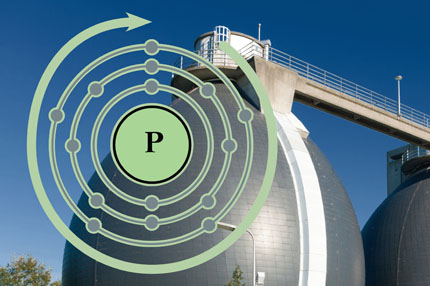5585 Guilford Road • Madison, WI 53711-5801 • 608-273-8080 • Fax 608-273-2021
www.agronomy.org
Twitter | Facebook
NEWS RELEASE
Contact: Hanna Jeske, Associate Director of Marketing and Brand Strategy, 608-268-3972, hjeske@sciencesocieties.org
A model approach for sustainable phosphorus recovery from wastewater
May 4, 2015 - A new approach to wastewater treatment may be key in efforts to reduce, reuse, and recycle. Moreover, it can be profitable.
Phosphorus is an essential element for human nutrition. It plays multiple roles in the human body, including the development of bones and teeth. Fertilizer with phosphorus, applied to crops or lawns, enables healthy growth. Without it, the basic cells of plants and animals, and life itself, would not exist.
Typically, phosphorus is found in phosphate-containing minerals that are mined—a limited and non-renewable resource. The annual demand is rising quickly. However, once used, phosphorus is difficult to reclaim.
 Where does the phosphorus go? In animals (including humans), urine contains phosphorus. Surface water carry large amounts of phosphorus from fields and lawns downstream. The result is phosphorus in water discharged by wastewater treatment plants (WWTPs).
Where does the phosphorus go? In animals (including humans), urine contains phosphorus. Surface water carry large amounts of phosphorus from fields and lawns downstream. The result is phosphorus in water discharged by wastewater treatment plants (WWTPs).
“Whatever phosphorus we use and discharge into rivers and oceans is lost to the environment,” says Rolf Halden, professor at the School of Sustainable Engineering and the Built Environment, and director of the Center for Environmental Security, Arizona State University.
Additionally, accumulation of phosphorus can result in problems like algae blooms in lakes and other surface water bodies. In turn, algae blooms deplete oxygen from the water, affecting the delicate balance of aquatic life. “This problem is observed in the seasonally recurring ‘dead zone’ of the Gulf of Mexico,” says Halden.
Halden’s group recently published a study in the Journal of Environmental Quality that examined methods for recovering phosphorus from wastewater using mathematical modeling. “WWTPs represent ground zero for addressing the problem of global phosphorus depletion,” Halden says.
WWTPs in many cities are currently implementing methods to extract phosphorus before discharging wastewater into the environment. There are two main types of phosphorus recovery methods: chemical and biological.
In the chemical method, WWTP treat phosphorus dissolved in wastewater. The phosphorus then falls out of solution for easier removal. In the biological method, bacteria introduced into the water collect the phosphorus into removable sludge. A variation includes enhanced biological phosphorus removal (EBPR). This method selectively encourages bacteria that can accumulate phosphorus.
Choosing a method is complicated. “The region’s water quality, size of the treatment plant, and economic considerations play a role in the selection,” explains the study’s lead author, Arjun Venkatesan.
Halden and Venkatesan’s study focused on a combination approach. First, EBPR concentrated phosphorus in sludge. Next, chemical treatment helped phosphorus fall out to form struvite, a usable phosphate mineral. The study showed that a typical WWTP could reclaim approximately 490 tons of phosphorus in the form of struvite each year.
Conventional methods remove only 40%-50% of P, according to Venkatesan. The secondary treatment of sludge employed by EBPR “achieves an additional 35% mass reduction, for a total of about 90% removal,” he says. EBPR helpfully avoids additional chemicals and reduces sludge production. Both these factors lower the cost of operation—a key consideration for WWTPs with limited budgets.
Reclaimed phosphorus pays off for the environment with less mining for phosphorus and improved surface water health. phosphorus recovered as struvite can also generate income. The team estimates that the WWTP used in their case study could generate $150,000 in annual revenue from this two-pronged approach. A plant with existing EBFR facilities can recoup the initial expenses in as little as 3 years.
“Nearly 367,500 tons per year of phosphorous could be generated with combined EBPR and struvite production,” says Halden, in plants with treatment capacity similar to the one used in the case study.
Such a payload can be a welcomed payoff for conscientious communities.
Journal of Environmental Quality publishes original research, reviews and analyses, and environmental issue articles that address anthropogenic impacts on water, soil, and the atmosphere and pertain to some aspect of environmental quality in natural and agricultural ecosystems.